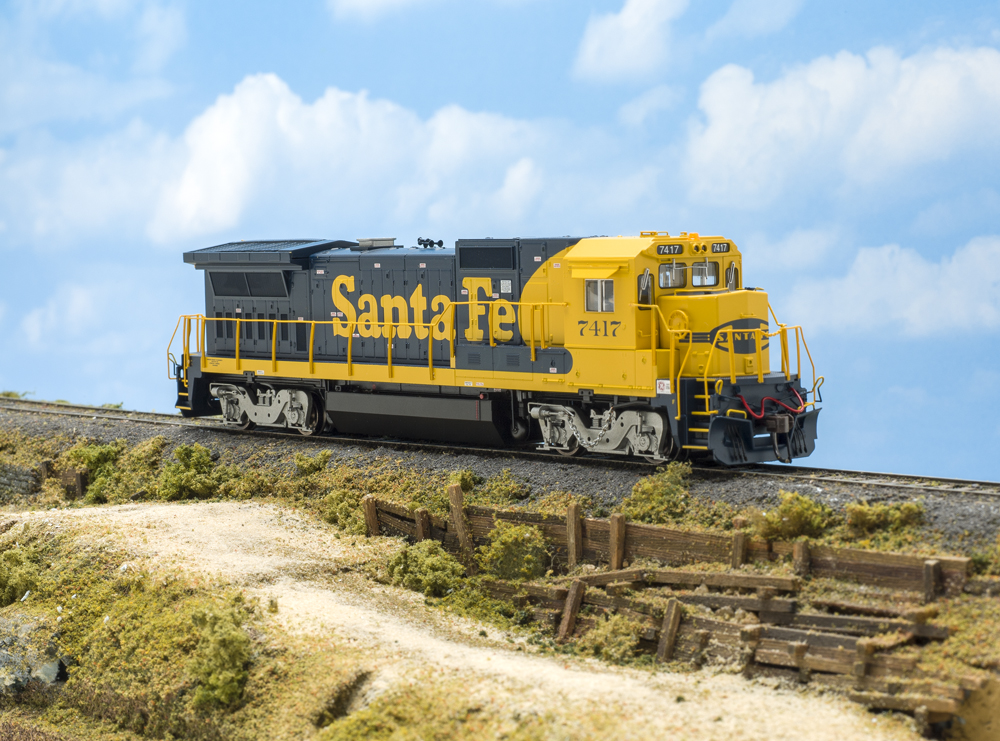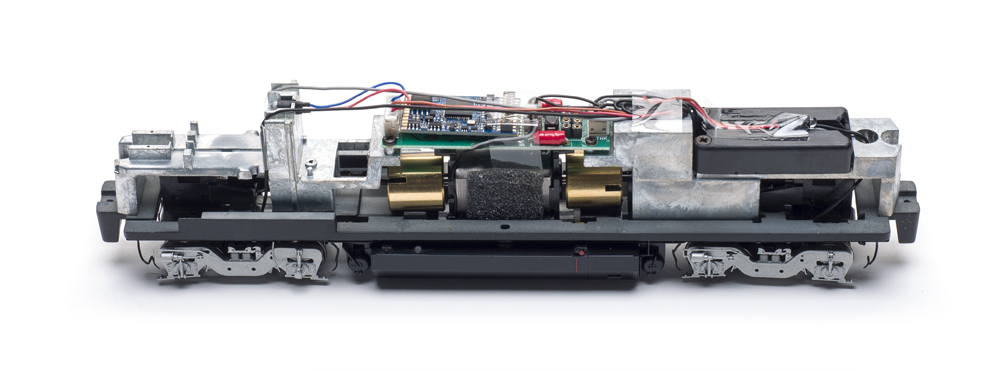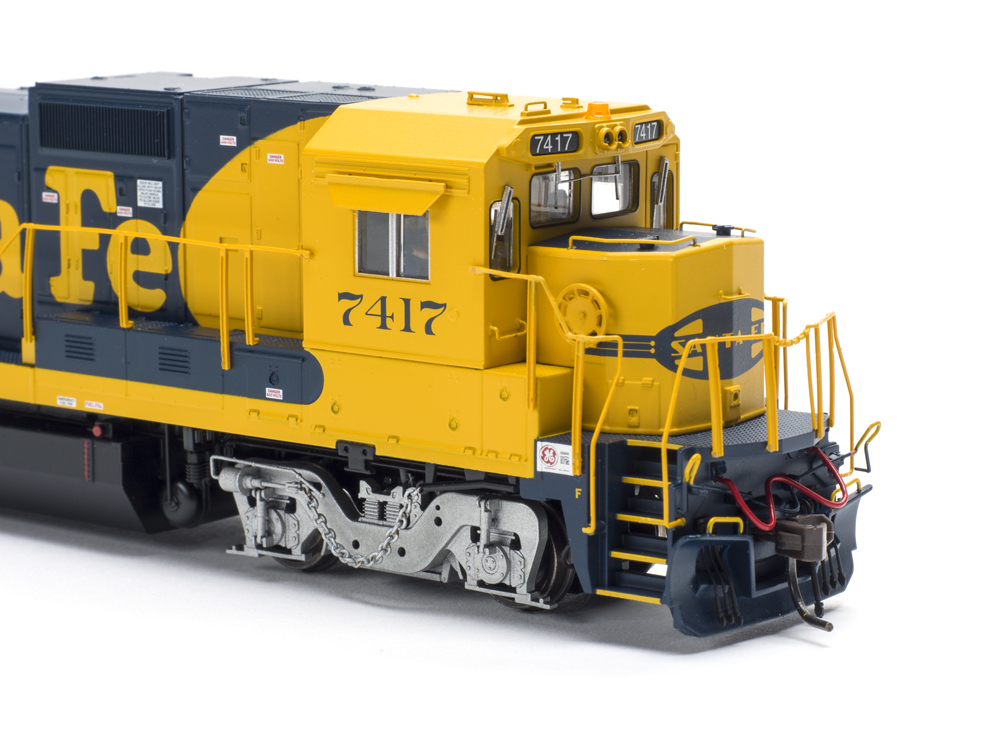
Atlas is back with its General Electric Dash 8-40B, originally released in 2001. The new model is now available with an Electronic Solutions Ulm (ESU) LokSound dual-mode decoder.
General Electric (GE) built 151 Dash 8-40B locomotives in 1988 and 1989 for Atchison, Topeka & Santa Fe; Conrail; New York, Susquehanna & Western; St. Louis Southwestern (Cotton Belt); the U.S. Department of Energy; and one kept by GE as a demonstrator. Secondhand owners include CSX, which acquired engines from Conrail and Susquehanna; BNSF Ry., all ex-ATSF; Union Pacific, from Southern Pacific via SSW (Cotton Belt); Providence & Worcester from Susquehanna; and Albany & Eastern, which came from CSX.
These locomotives are still working for some of their second (or third) owners, but they’re essentially gone from Class 1 service. The Illinois Railway Museum has UP no. 1848, ex-Cotton Belt no. 8049.
These 4,000hp locomotives used GE’s FDL 16-cylinder diesel engine and microprocessor control for improved efficiency over earlier locomotives. The four-axle locomotives rode on GE floating bolster (FB) trucks. Class 1 customers purchased these high-horsepower locomotives to move fast intermodal traffic efficiently, and the four-axle locomotives were the best solution in the late 1980s and early 1990s. By the middle ’90s, the units were being replaced by six-axle power. The Dash 8-40 line would be the last four-axle models offered by GE.
Our sample is decorated as Santa Fe no. 7417, one of Atchison, Topeka & Santa Fe’s initial order for 20 Dash 8-40Bs, built in June 1988. Another 20 were built in April 1989. (Santa Fe eventually purchased another 83 Dash 8-40BW locomotives with the North American Safety cab.)
Comparing the model to dimensions published in the April 1989 Model Railroader, the truck center-to-center spacing is almost 1 scale foot short. The overall locomotive length is within scale inches of those drawings, meaning the trucks are about 6″ farther in from the ends on the model than they are on the prototype.

There are a few other discrepancies between the model and the Santa Fe prototype. The Santa Fe ordered smaller fuel tanks, 3,250 gallons vs. 3,900 on other railroads’ orders. Also, Santa Fe opted for headlights mounted in the front of the low hood instead of between the number box above the cab windows. And on top of the cab, Santa Fe ordered air conditioner units, which are absent on the model.
General Electric plated over the headlight locations at the top of the cab on the Santa Fe orders, so modelers could do the same with a bit of shim brass. Air conditioner castings are available from detail parts suppliers, and the fuel tank is molded in two separate plastic halves, so they could be removed and reworked to simulate the smaller Santa Fe versions.
If you’re not modeling the Santa Fe, these are non-issues. Other road names have specific details appropriate to their paint schemes (including air conditioners). None of the others have shorter fuel tanks, which appears to be true of the prototypes as well.
There is much to appreciate on these models. Separately applied, painted wire grab irons and handrails adorn the body shell. Photo-etched metal grills add depth to the radiators. Uncoupling levers, m.u. cables and hoses, brake lines, and grab irons add interest to the pilots, plus in front, there’s a snowplow.
The cab has an amber rotary beacon and antennas on its roof and modelerinstalled sunshades over the side windows. Painted crew members take their places inside the cab.
The FB trucks have separately applied dampers, brake cylinders, and a brake chain on the engineer’s side of the locomotive. The die-cast metal frame has appropriate flange detail and piping, and there are air and sand line details as well.
The paint is smooth and opaque with sharp separations between the blue and yellow sections of the warbonnet scheme, and the Santa Fe billboard lettering is sharp and opaque against the blue surrounding it. Yellow paint is always an adventure on models.

General Electric builders plates adorn the sides of the walkways in front of the cab, and it appears nearly every door on the long hood has a warning label of some sort. The frame rails have labels indicating fuel fill, lube oil fill, and drain locations, ownership details of the locomotive, and even an emergency fuel cutoff label on the frame above the front air tank. Nicely done!
Under the hood is a die-cast metal chassis. To separate the body shell, start by removing the coupler boxes. Then carefully detach the brake chain from the small plastic hook under the cab on the engineer’s side.
Mounted in the middle of the frame is a five-pole, skew-wound can motor with brass flywheels. Die-cast metal weights are secured above the front and rear trucks and drive train. All wheels are driven and pick up power from the track.
A printed-circuit (PC) board motherboard is attached with screws to the weights above the motor, and the ESU LokSound V5 decoder is plugged into the motherboard with a 21-pin plug. A downward-facing speaker is mounted in an enclosure above the rear truck. A single light-emitting diode (LED) illuminates the headlight and number boxes. As on the prototype, the number boxes are painted over on the rear of the Santa Fe locomotive.
I started testing on my home switching layout using my NCE PowerCab. The ESU LokSound V5 decoder didn’t hold many surprises, smoothly starting the locomotive, but in speed step 2 instead of step 1. I adjusted Configuration Variable (CV) 2 to increase the starting voltage. I changed the value to 6 (from the default 3). After this adjustment, the locomotive recorded 1.76 scale mph in speed step 1. Top speed was 71 scale mph in speed step 28, similar to the prototype’s top speed. All of the typical features are available with this decoder, with headlights at function 0 (F0), bell at F1, horn at F2, and engine startup at F8. Testing at home, I make use of CV63 to reduce the overall volume significantly. A setting of about 50 meets with the other living room occupants’ approval.
I tested the locomotive with my trusty Model Rectifier Corp. Tech II Railmaster 2400 with the pulse power switched off. Sound started at about 8.5V with an engine startup sequence. The locomotive started moving at nearly 10V at 2 scale mph and topped out at 76 scale mph at the maximum output of 13V. The four-axle road switcher was perfectly happy negotiating Atlas no. 4 turnouts and pushing and pulling cars on my switching layout.
This is another in a long line of quality locomotives from Atlas. The detail meets current standards, despite a few roadname-specific discrepancies; the paint and performance are top-notch; and the sound system is fun and easy to use. If you need to haul time-sensitive freight across your 1990s-era layout, be sure to check these models out.
Facts & features
Price: $289.95 (DCC, sound), $179.95 (DC, no sound)
Manufacturer
Atlas Model Railroad Co. Inc.
378 Florence Ave.
Hillside, NJ 07205
atlasrr.com
Era: 1989 through approximately 1999 (as decorated)
Road names: Atchison, Topeka & Santa Fe; Albany & Eastern; Conrail; CSX (ex-NS); New York, Susquehanna & Western; Providence & Worcester; St. Louis Southwestern (Cotton Belt); Union Pacific; and undecorated
Features
• Accumate knuckle couplers, mounted at correct height
• Detailed trucks
• Die-cast metal underframe
• Directional lighting
• Five-pole skewed armature motor with dual flywheels
• Painted crew figures
• Separate, factory-installed scale windshield wipers, metal grab irons and fine scale handrails
• Snowplow
• Weight: 1 pound, .4 ounces














One statistic I always look for in a loco is pulling power. Missing here. Was that in a printed version of the review?